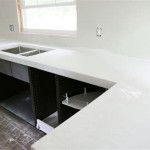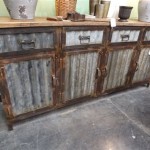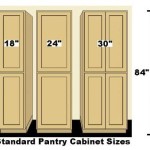How To Refinish Veneer Kitchen Cabinets
Refinishing veneer kitchen cabinets is a cost-effective alternative to replacing them entirely. While veneer cabinets can be more delicate than solid wood, with careful preparation and technique, they can be successfully refinished, providing a refreshed look to a kitchen without a significant financial investment. The process requires patience and attention to detail, but the results are often well worth the effort.
Before embarking on this project, it is crucial to understand the nature of veneer. Veneer is a thin layer of real wood adhered to a substrate, typically particleboard or MDF (Medium-Density Fiberboard). Its thinness makes it susceptible to damage during sanding, so extra caution is required. Aggressive sanding can easily penetrate the veneer, exposing the underlying material and rendering the cabinet irreparable. Therefore, gentle techniques and appropriate materials are essential.
This article will provide a comprehensive guide to refinishing veneer kitchen cabinets, covering essential steps from preparation to finishing. It will outline the necessary tools and materials, detail the proper sanding techniques, and offer guidance on selecting and applying the appropriate finish. By following these instructions, homeowners can achieve a professional-looking result and extend the life of their kitchen cabinets.
Key Point 1: Preparation is Paramount
Proper preparation is the most crucial step in refinishing veneer kitchen cabinets. This stage sets the foundation for a successful outcome and minimizes the risk of damaging the delicate veneer surface. Insufficient preparation can lead to uneven finishes, peeling paint, or even irreversible damage to the cabinets.
The first step is to thoroughly clean the cabinets. Over time, kitchen cabinets accumulate grease, grime, and dust. These contaminants can interfere with the adhesion of the new finish, leading to peeling or bubbling. Use a degreasing cleaner specifically designed for kitchen surfaces. Avoid harsh chemicals that can damage the veneer or the underlying substrate. Apply the cleaner with a soft cloth or sponge, and rinse thoroughly with clean water. Allow the cabinets to dry completely before proceeding.
Next, remove all hardware, including knobs, pulls, hinges, and latches. Store the hardware in a labeled container to avoid confusion during reassembly. This step ensures that the finish is applied evenly to all surfaces and prevents the hardware from being damaged or stained during the refinishing process. If hinges are dated, photograph their placement before removing them entirely. This ensures a smooth reinstallation.
After removing the hardware, inspect the cabinets for any damage, such as scratches, dents, or chips. Minor imperfections can be filled with wood filler specifically designed for veneer. Apply the filler according to the manufacturer's instructions, and allow it to dry completely. Once the filler is dry, sand it smooth with fine-grit sandpaper. For more significant damage, consider consulting a professional for repair.
Masking off surrounding areas is also an important part of the preparation process. Use painter's tape to protect countertops, walls, floors, and appliances from paint or stain. Cover large areas with drop cloths or plastic sheeting to prevent splatters and spills. This will save time and effort on cleanup after the refinishing is complete.
Finally, create a well-ventilated workspace. Refinishing products often contain volatile organic compounds (VOCs) that can be harmful if inhaled. Open windows and doors to provide adequate ventilation, or use a fan to circulate the air. Consider wearing a respirator to protect yourself from fumes. A well ventilated workspace is essential for both safety and ensuring proper drying of finishes.
Key Point 2: Sanding with Precision
Sanding is a critical step in refinishing veneer kitchen cabinets, but it must be approached with caution due to the thinness of the veneer. The goal is to create a smooth, even surface for the new finish to adhere to, without sanding through the veneer layer. Excessive sanding can expose the underlying substrate, which is difficult to repair and will ruin the appearance of the cabinets.
Begin with a light sanding using fine-grit sandpaper, typically 220-grit or higher. Use a sanding block or orbital sander for larger surfaces, but be careful not to apply too much pressure. The purpose of this initial sanding is to scuff the existing finish and create a slightly rough surface for the new finish to grip. Avoid aggressive sanding that can remove the veneer. Instead, focus on lightly abrading the surface.
For intricate details or hard-to-reach areas, use a sanding sponge or hand-sanding techniques. These tools provide more control and allow you to sand carefully around corners and edges. Be especially cautious when sanding edges, as the veneer is often thinner in these areas.
After sanding, remove all sanding dust with a tack cloth or a vacuum cleaner with a soft brush attachment. Sanding dust can interfere with the adhesion of the new finish, so it is important to remove it thoroughly. Wipe down the cabinets with a damp cloth to remove any remaining dust. Allow the cabinets to dry completely before proceeding.
If the existing finish is particularly glossy or resistant to sanding, consider using a chemical deglosser. These products soften the finish and make it easier to sand. Follow the manufacturer's instructions carefully, and allow the deglosser to dry completely before sanding. Chemical deglossers are particularly useful for cabinets with multiple layers of old paint or varnish.
Throughout the sanding process, regularly inspect the veneer for any signs of damage. If you notice any areas where the veneer is starting to thin or peel, stop sanding immediately. Attempting to sand these areas further will only exacerbate the problem. Instead, consider using a wood filler to repair the damage before proceeding with the refinishing.
Key Point 3: Applying the Finish with Care
Selecting and applying the appropriate finish is the final, and arguably most important, step in refinishing veneer kitchen cabinets. The finish not only protects the cabinets from moisture and wear, but also determines their final appearance. Choosing the right product and applying it correctly will ensure a durable and beautiful result.
There are several types of finishes suitable for veneer kitchen cabinets, including paint, stain, and clear coat. Paint is a popular choice for achieving a modern or contemporary look, while stain can enhance the natural grain of the wood. Clear coat provides a protective layer over the stain or bare wood, adding durability and sheen.
When choosing a finish, consider the existing style of your kitchen and the desired aesthetic. Also, consider the level of durability required. Kitchen cabinets are subject to frequent use and exposure to moisture, so it is important to choose a finish that is resistant to scratches, stains, and water damage.
Before applying the finish, prime the cabinets with a high-quality primer. Primer creates a smooth, even surface for the finish to adhere to and helps to block stains from bleeding through. Apply the primer in thin, even coats, using a brush, roller, or sprayer. Allow the primer to dry completely before proceeding.
When applying the finish, use a brush, roller, or sprayer to apply thin, even coats. Avoid applying too much finish at once, as this can lead to drips, runs, and uneven coverage. Allow each coat to dry completely before applying the next. Lightly sand between coats with fine-grit sandpaper to create a smooth surface.
If using a sprayer, be sure to protect surrounding areas from overspray. Mask off countertops, walls, floors, and appliances with painter's tape and plastic sheeting. Adjust the sprayer settings to achieve a fine, even mist. Practice spraying on a piece of cardboard or scrap wood before applying the finish to the cabinets.
After applying the final coat of finish, allow the cabinets to dry completely before reassembling the hardware. Follow the manufacturer's instructions for drying time. Once the cabinets are dry, carefully reattach the knobs, pulls, hinges, and latches. Inspect the cabinets for any imperfections and touch up as needed.
Proper curing time is also essential for the durability of the finish. Avoid exposing the cabinets to excessive moisture or heavy use during the curing period. Allow the finish to cure completely before cleaning the cabinets with harsh chemicals. With proper care and maintenance, your refinished veneer kitchen cabinets will provide years of beauty and functionality.

Refinishing Kitchen Cabinets Modern Refacing Made Easy Wisewood

How To Paint Veneer Cabinets For A Long Lasting Finish Anika S Diy Life

Refinishing Kitchen Cabinets Modern Refacing Made Easy Wisewood

How To Paint Veneer Cabinets For A Long Lasting Finish Anika S Diy Life

How To Reface Kitchen Cabinets With Veneer

Refinishing Kitchen Cabinets Modern Refacing Made Easy Wisewood

Refinish Kitchen Cabinets With Kilz Restoration Primer

How To Paint Veneer Cabinets For A Long Lasting Finish Anika S Diy Life

How To Paint Veneer Cabinets For A Long Lasting Finish Anika S Diy Life Painting Laminate Kitchen Wood Bathroom

How To Use Wood Veneer Reface Kitchen Cabinets Diy Cabinet Update
Related Posts








